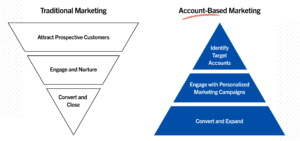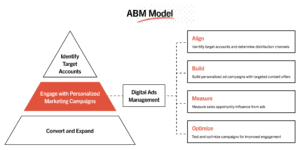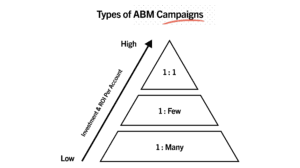What is Account Based Marketing?
Account-based marketing (ABM) is a personalized approach to B2B SaaS marketing that focuses on identifying, targeting, engaging, and converting strategic or high-value accounts into paying customers of the business.

High-value target accounts are identified by the SaaS sales/marketing team with input from other stakeholders, and may be chosen for their strategic value, or because they match the selling organization’s ideal customer profile. An ABM strategy allows you to focus your sales/marketing resources on the best accounts – the ones with the highest predicted customer lifelong value (CLV/LTV) and the greatest chance of becoming your customer.
In a traditional inbound marketing campaign, marketers attempt to attract a large number of prospective customers into the top of the funnel, engage and nurture those prospects through the middle, and convert the best leads into customers at the bottom of the funnel. Top-of-funnel ads may be targeted based on demographic or behavioral data.
With an ABM approach, B2B companies identify the best and most profitable target accounts before they launch marketing activities. By narrowing down the list of potential targets, B2B companies can craft personalized content and advertisements that speak directly to each target account’s unique attributes and pain points.
After converting the prospect into a customer, B2B SaaS companies can continue the account-based strategy with personalized support and nurturance that leads to increased retention, as well as up-sell and cross-sell opportunities.
How Does Account Based Marketing Work?
Account-based marketing is a highly targeted, highly personalized approach to gaining new customers for your B2B SaaS business.
The basic process for account-based marketing consists of three core activities that take place in sequence:
- Identify Target Accounts
- Engage with Personalized Marketing Campaigns
- Convert and Expand

Identify Target Accounts
The first step in an ABM strategy is to identify target accounts. As a starting point, B2B SaaS marketing teams should talk to their colleagues in sales, investigate customer data, and survey existing customers to define their total addressable market (TAM) and formulate an ideal customer profile (ICP).
Marketers should choose to target prospective customers who strongly match their ICP, indicating a high likelihood that they will become customers in the future. Marketers may also wish to pursue reputation-enhancing partnerships with high-profile customers.
Engage with Personalized Marketing Campaigns
After identifying target accounts, the next step is to engage those accounts with personalized marketing campaigns.
Creating highly-customized campaigns for specific accounts is expensive, so it’s normal for marketers to reduce the level of personalization when there are lots of accounts to target, or to focus their resources for marketing personalization on the most important target accounts.

At Directive, we often segment target accounts into three tiers, applying the greatest level of marketing personalization for high-priority Tier 1 accounts, and the least for lower-priority Tier 3 accounts. Accounts in the middle tier will be clustered into small groups and receive lightly customized messaging according to their shared attributes and pain points.
In an ideal world, every target account would receive 1:1 personalization – but in practice, our system does a much better job of winning high-value accounts and maximizing overall ROI.
Convert and Expand
After successfully engaging and building relationships with target accounts, B2B SaaS companies can schedule a product demo and hopefully convert the prospect into a paying customer.
But it doesn’t stop there. Existing customers must be effectively nurtured and supported to prevent churn, and account managers should also be developing up-sell and cross-sell opportunities with their existing customers – not just chasing the next customer all the time.
An account-based approach acknowledges that B2B SaaS businesses can grow by expanding their relationships with existing customers – not just by developing new ones.
Is Account-Based Marketing Right For My Company?
Can you imagine if a company like Netflix tried to gain their next 5 million subscribers with an account-based marketing strategy?
They would need to collect data on millions of people, segment the data based on likelihood to subscribe, create personalized content and advertisements for millions, and hire thousands of account managers. Stack up all of those costs next to their $8.99 monthly subscription, and they’d never make a profit.
So what’s the lesson?
Account-based marketing is a powerful approach, but that doesn’t make it the best solution for every business model. Below are four conditions under which you should consider an account-based marketing strategy.
When Your Total Addressable Market (TAM) is Small
If your business operates in a niche industry where your total addressable market is small (e.g. fewer than 10,000 potential customers), it often makes sense to focus your marketing efforts on those firms directly with an account-based marketing approach.
A small target market makes each individual win/loss more important to the outcome, so it’s crucial to take a personalized approach that maximizes your win potential with each account.
When Your Sales Cycles is Long
When your B2B sales cycles are long, with potentially dozens of customer touch points along the way, it makes sense to follow an ABM strategy. Personalized marketing plays demonstrate a high level of customer care, enabling your account managers to start sales conversations earlier in the process and accelerate the sales process.
When Adopting Your Product/Solution Involves Many Stakeholders
When adopting your product involves input and consensus between many stakeholders, it makes sense to adopt an ABM strategy. An account manager can work to identify key stakeholders in the target organization, encourage those stakeholders to champion your product, and drive the overall consensus towards adoption.
When Customer Lifetime Value (CLV) is High
Account-based marketing is a costly approach that’s justified by the high customer lifelong value (CLV) of target accounts. When the CLV of an account is high, it makes sense to adopt a personalized ABM strategy that shortens the sale cycle and maximizes the likelihood of winning the account. When CLV is low, it may be difficult or impossible to generate profit with an account-based marketing approach.
How Does ABM Impact SaaS Business Success?
B2B SaaS companies have reported impressive results from account-based marketing, including increased pipeline velocity and win rates, bigger deal sizes, and enhanced customer retention.
At Directive, we recently deployed an ABM strategy on LinkedIn to increase paid leads for one of our SaaS clients in the healthcare vertical. Using the platform’s advanced targeting features, we sent personalized ads to employees at specific companies (our target accounts), even targeting individuals by their job roles and medical skill set.
With our personalized targeting efforts, we increased our customer’s paid leads by over 30%, traffic from LinkedIn by over 100%, and reduced cost-per-acquisition by 70%.
To learn how Directive applied a customer-led ABM approach to LinkedIn, book an intro call and visit Customer Generation.